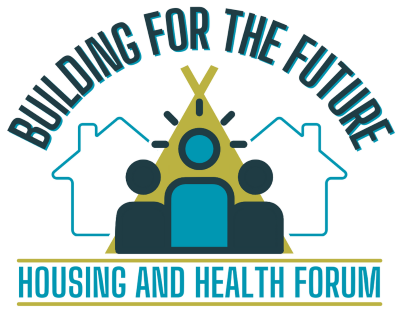
First Nations Housing Symposium combines research and knowledge with action and art
Building for the Future, a housing symposium dedicated to Indigenous housing and health, took place on November 21st, 2023, at Wanuskewin near Saskatoon. The one-day event drew participants from across the province, including representatives from First Nations communities, the building industry, NGOs, and government.
By Merle Massie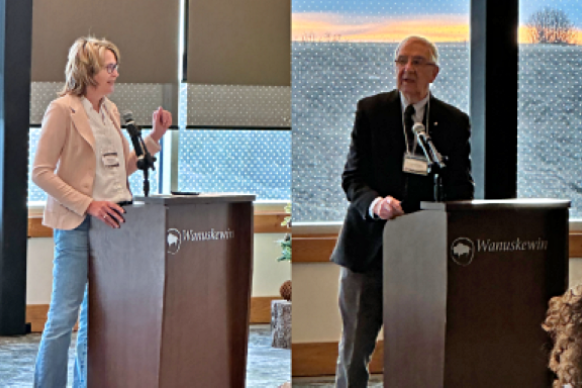
Dr. Shelley Kirychuk, alongside Dr. Jim Dosman from the Canadian Centre for Rural and Agricultural Health, opened the Symposium by sharing insights drawn from nearly fifteen years of research with First Nations in Saskatchewan. Their findings underscore a stark reality: housing conditions such as dampness, mold, overcrowding, and disrepair significantly impact health outcomes, leading to conditions like chronic bronchitis, wheezing, sleep deprivation, and more.
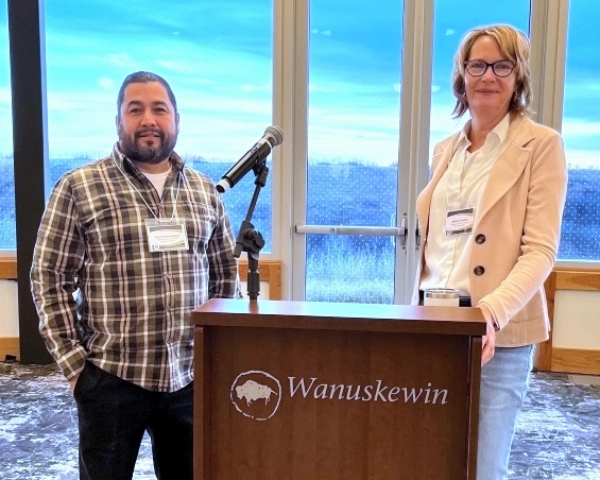
Jeremy Seeseequasis, a member of the Beardy’s & Okemasis Cree Nation, has actively participated in community-centered research. Seeseequasis offered a community perspective, emphasizing that the effort to understand the link between housing and health in his community goes beyond mere reconciliation; it's about taking concrete actions toward reconciliACTION.
The collaborative effort involves a multidisciplinary team of researchers from the University of Saskatchewan (USask), spanning various fields such as medicine (led by Dr. Shelley Kirychuk, PhD), engineering (led by Dr. Kerry McPhedran, PhD, Dr. Soltan Jafar, PhD, and Dr. Huiqing Guo, PhD), social and cultural design within engineering (led by Dr. Lori Bradford, PhD), nursing (led by Dr. Wanda Martin, PhD, and Dr. Charlene Thompson, PhD), and chemistry (led by Dr. Tara Kahan, PhD).
Community partners attending the Symposium looked to develop the practical impact of the research findings and identify future directions. Managing on-reserve housing portfolios involves juggling tasks, policies, and programs such as construction, maintenance, renovation, support services, training, social and cultural needs, politics and reporting, all of which can make housing complex. Effectively addressing the links between housing, health, and wellbeing requires long-term collaboration and joint actions to improve on-reserve housing and infrastructure for seven generations to come.
This is where the Symposium, and continued work, plays a role. Communities have been sharing examples and stories of their housing strengths and successes with the USask research team in person during community visits, or through Zoom and phone conversations in the Summer and Fall 2023, and continued conversations are being planned for Summer 2024.
Community representatives prefer a strength-based perspective, which directed the focus of these conversations and upcoming research. Communities shared positive stories of what was happening in different First Nations communities across the province and how those practices strengthened housing. Our next task is to organize and share those practices.
For that sharing, we are preparing a centralized hub of information based on four themes: governance and policy; transition and training; builds and procurement, and asset management. The hub can showcase both community stories of housing strength and provide a portal to existing and new resources.
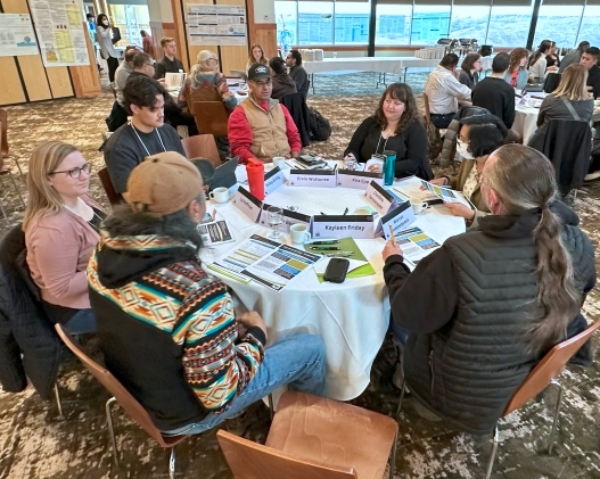
The Symposium was a welcoming forum to share community examples among diverse attendees at each table. Each table then engaged in lively discussions to expand and develop the themes.
As the room filled with insight and shared stories, the discussion was captured in-the-moment by a graphic recording artist from Fuselight Creative. The artist’s interpretation of the insights was projected for everyone to see and build on. Graphic recording is a developing practice of distilling information into a visual format.
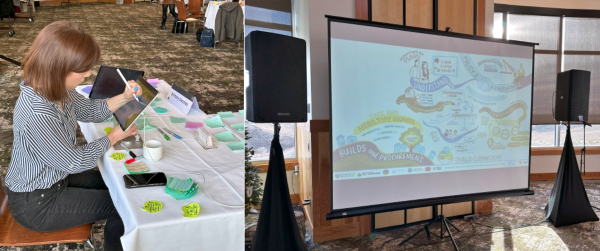
Brittany from Fuselight working on the graphic recording - Graphic recording shown as it was captured in real time during Symposium.
After the Symposium, the visual rendering was converted into a video, showing how the art was developed, capturing the conversations.
The video was also set to music. The USask team chose Kahkiyaw Oskâyak (All the Young People), an original composition by distinguished Cree-Dene musical artist and creator Sherryl Sewepagaham. The version used was performed by the USask Greystone Singers, directed by Dr Jennifer Lang (PhD). The song encapsulates the enthusiasm of shared voices and resonates with the energy of the symposium.
The combined graphic recording and music, which is publicly available on YouTube, is an example of how research insights and artistic expression can be blended to share knowledge in new ways.
Attendees praised the event, highlighting the discussion format and artistic elements as particularly noteworthy. They commended the engagement, networking opportunities, and the chance to connect with others who were grappling with similar housing challenges as among their favourite aspects of the day.
Attendees urged researchers to continue enhancing engagement and networking efforts. They issued a challenge for University of Saskatchewan (USask) researchers to collaborate with other First Nations communities, share resources, and maintain ongoing communication and follow-up.
A graphic summary of what was shared, and the video from the day are available on the Built Environment research website. More outcomes, including a framework and report from the Symposium, as well as an online hub with information for on-reserve housing managers, directors, and leadership, are forthcoming. The team has been in regular touchback with communities and their insight will guide focused subgroups as the hub and other opportunities for networking evolve.

